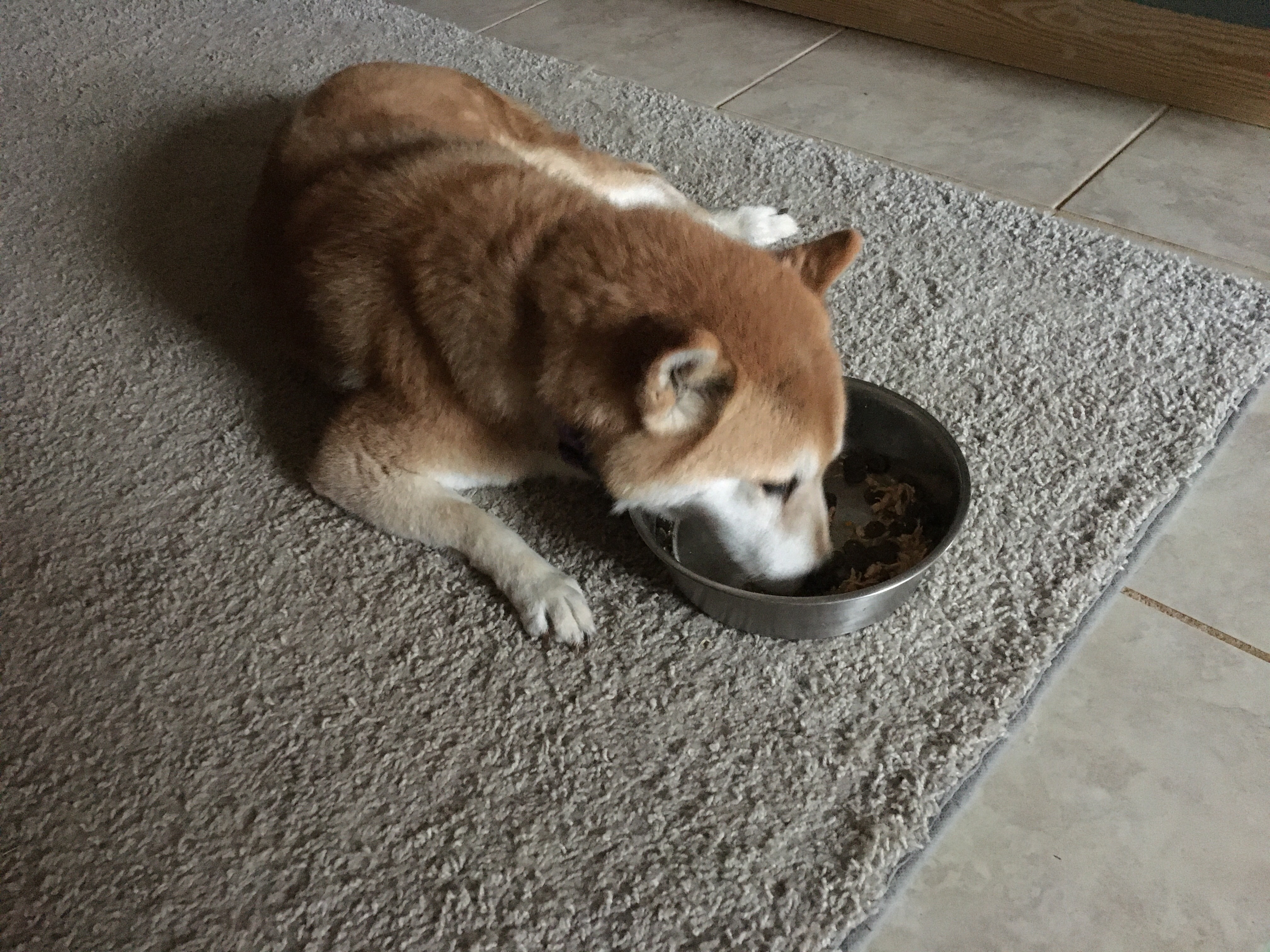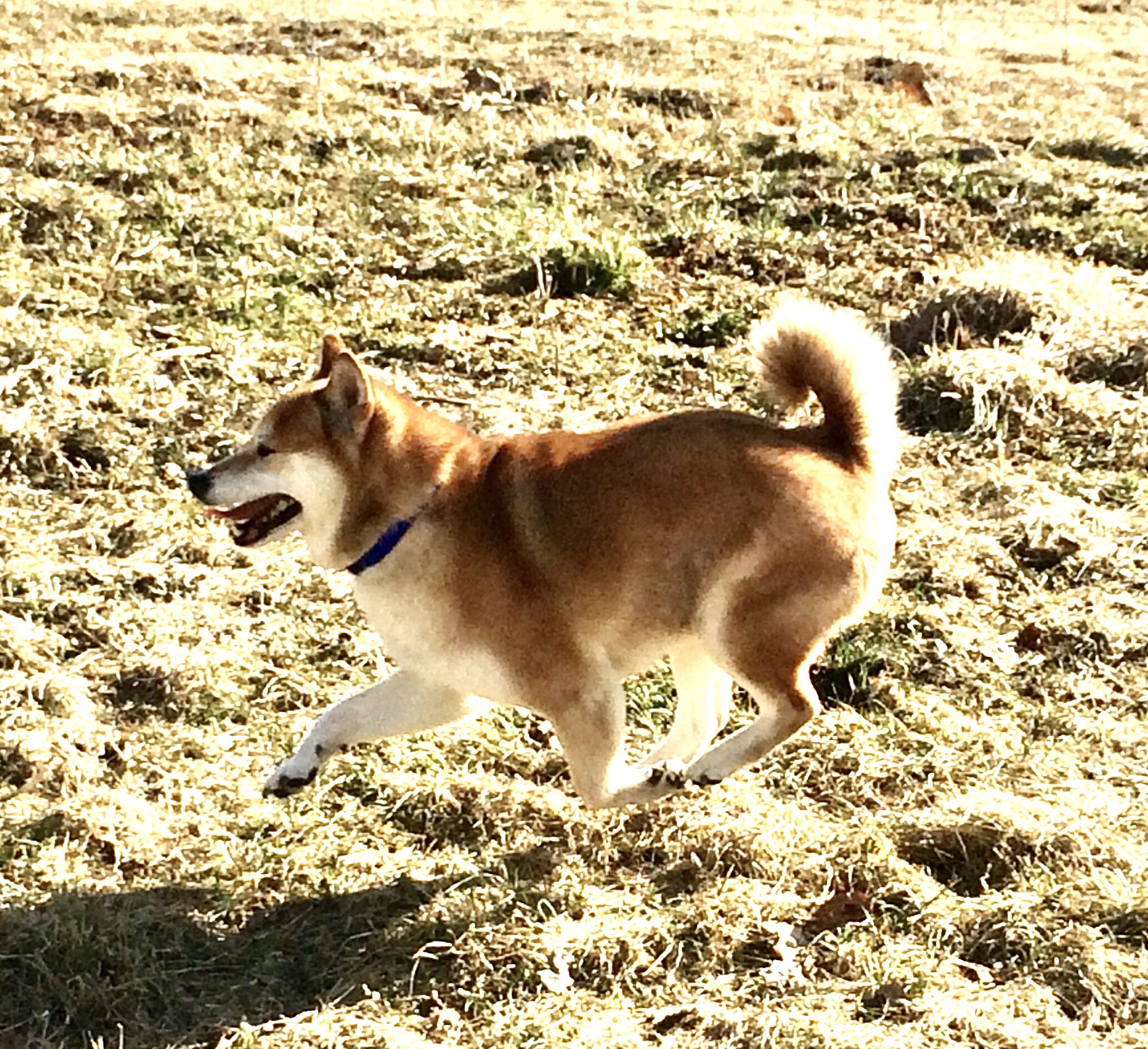
Sasha is not just old. She is old and deaf and blind. And although it seemed for a while that her sense of smell was helping her get around, I’ve come to think that that too is failing. As are her legs. She now wobbles her way to standing.
Sasha is 15 or 16 years old, well into the realm of canine elderhood. We don’t know her actual age because she came to us late in life as a gift. I went searching for a companion for Ursa, my first adopted-late-in-life dog (late in her life, late in mine) because I was working away from home and worried about her being alone too much, suspecting that any alone time is too much for a dog.
Sasha’s adoring former owners met Ursa and me, and approved, and Sasha came home with us that day. Because she was meant to be Ursa’s companion, I didn’t see the need to bond with her myself. This appeared to suit Sasha who wasn’t looking for a close relationship, at least not one built on any obvious canine enthusiastic efforts to please. She didn’t ostensibly buddy up with me nor with Ursa. Nothing contentious, nothing cozy. Simply contented coexistence.
Then things changed. Ursa died, we moved, and the pandemic grounded me at home. My own oldness plus my partner’s even more oldness, well, that adds up to caution is a good idea. I used to travel a lot for work that is near and dear to me. Now I’m home, and hanging out with Sasha is starting to fill this need for feeling near and dear to something. Which also means I ache with each new sign of her decline.
Sasha’s life is like this: sleep, sleep, pee, drink water, sleep, pee, drink water, sleep, sleep, pee, poop, drink water, eat, sleep, sniff around for a snack, sleep, sleep, sleep.
Our daily challenge is to help her get outside to pee and poop before she pees and poops in the house. I have not been a dog person for most of my life. I have been a cat person. Indoor cats tend to be loyal users of their litter box. And yes, with the ancient cats I’ve owned, there were “accidents” like when Millie couldn’t navigate to the litter box or Ema couldn’t navigate into the litter box. But generally they seem to prefer to pee and poop exactly where I expect them to — in the litter box — and I prefer that, too. Not so easy and predictable with Sasha.
I can now interpret some of Sasha’s behaviors as “I gotta pee. Is there anyone who will help me get outside?” But my attention is required in order to help her. Sometimes I’m elsewhere physically. Sometimes I’m elsewhere mentally. Either way, if she’s gotta go, she’s gotta go. And lately we have more times of finding pee and poop in the house.
There are other behaviors I can interpret. I’m hungry: she walks around sniffing sniffing sniffing, sometimes waiting near the snack cabinet. I’ve eaten and I want more: she walks around sniffing and licking the floors as she goes, usually after dinner or evening snack time. I’m tired: she circles, lies down, and falls asleep. This is probably the easiest behavior to decipher although it can be the scariest. Because when she’s asleep her breathing rate drops to about one breath every hour. I stand very, very still, watching her body, looking for signs of life. Eventually there’s the rise and fall of another inhale and exhale. At which point I exhale. It’s stressful watching daily reruns of the Doggie Dead or Alive Quiz Show.
It bothers me when she pees and poops in the house. We have all the best tools (at least I hope they’re the best) for cleaning up and I hope the house doesn’t increasingly smell like old dog pee and poop. Which could mean the old pee and poop of a dog, or the pee and poop of an old dog. Either way, I don’t want that lingering in our home. And if I’m living with it 24/7, I’m not going to notice until I’m outside and returning inside. Then whammo. The Smell.
There’s another reason I’m bothered by Sasha’s peeing and pooping indoors. She’s doing this because she’s very, very old. And I never know from day to day if this behavior will become the norm, or if it’s still the odd time when she can’t hold it or she forgot how to find us. Or even if she’ll still be alive. However much I’d like to stop worrying about the indoor peeing and pooping, I don’t wish her dead to solve that problem.
She does find us by smell. Or if we’re walking near her and our footsteps vibrate the floor. Her ability to smell and orient, although failing, seems to have improved since she was first blind and kept slamming into chairs, cabinets, walls. She sometimes finds me and touches my leg with her snout. I like this. Clear communication. Although her need is not always clear. Sometimes her Shiba Inu curled tail helps me guess correctly.When it’s not curled, I know something’s off and she needs help.
Here’s the routine for going out to pee and poop once we know this is probably what she wants. Guide her by her collar toward the back door, pausing with her when she stops to consider the accuracy of our direction. Proceed when she’s ready. Hook up the end of the cable leash that we keep inside (the other end is tethered outside). Open the back door and the storm door and walk out making sure she doesn’t walk into either door while making sure I hold the storm door long enough to keep it from whacking her left hind leg as it closes. Accompany her across the concrete patio and release her once we’re on the gravelly lawn where she’ll pee, and maybe poop.
This cable leash is The Security System, guarding against Sasha wandering off. Although she often simply stands still after peeing, waiting to be found and guided indoors, she sometimes sniffs around exploring scents as dogs will do. I know she could easily just keep following her nose. Then we’d go to bring her in and she wouldn’t be there. She wouldn’t know she’s lost and we wouldn’t know where to find her. When she’s tethered and in sight, this won’t happen. Just thinking that she might wander off untethered takes my breath away.
Sasha does find the water dish by herself. This is especially easy after being out to pee. I guide her in through the doorway, we stop while I unhook her from the cable leash, then she swerves to the right and eventually closes in on the water bowl. Bumping into the bowl is her cue to lift her head, step closer, lower her head, and drink. She’s quite handy with this although I have observed her wander off course adding a few extra miles to her search for water.
What to do when she can’t find the water herself? What to do if her indoor pee and poop behaviors become a daily thing? Sure, we can set up a fenced off area to contain where she pees and poops, even lay out those doggy pads advertised as waterproof. And yes, they are very much like the underpads used for incontinent older people or younger people who for whatever reasons are leaking urine or full on peeing in bed. Yes, we could do that. Would it matter to Sasha? Would she miss wandering around sniffing and licking? Would she mind not finding that sunny spot in the living room? Would we mind containing her and cleaning up after her day in and day out?
There is something that strikes me as deeply pathetic and somewhat terrifying to watch her, knowing that she relies on the attention and the interventions of others (like me, for example). This could be The Real Reason #1 in the list of what bothers me. How would I fare in similar circumstances? My gut tightens when I imagine being deaf and blind and relying on the good intentions of others and their ability to observe and interpret what I need. Of course I would have the advantage of speech, at least in my imagination I do. But what if nobody heard me? Sasha doesn’t bark to announce her needing something whereas I can bark my signal call. And assuming my legs work, I can bumble my way through a familiar landscape to seek and find things. What if I were left to fend for myself? What if, what if, what if?
Strategizing these scenarios about Sasha cushions me from the intensity of my own love of life and reluctance to die. I realize I may not have time to be reluctant about dying if it comes suddenly. But I have the luxury ahead of time to fret. About my possible degeneration and incapacitation. About Sasha’s which I’m witnessing day by day. How can I know if this good-natured deaf and blind dog is at peace with these quality of life changes? I remind myself I had a sense of now’s-the-time with Ursa. And I pause my fretting long enough to assure myself that with Sasha I will again know now’s-the-time.
Until then, I’ll keep an eye out for her not-so-enigmatic signs of need. So I can feel useful. So she can maintain some of her lifestyle habits. So I can imagine we’re both blissfully ignorant in this moment despite my knowing what statistics insist will happen sooner than later. Living the best we can even while the timer is running out.
